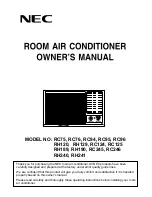
351579-YTS-B-0608
6
Johnson Controls Unitary Products
monitoring and control. Much like we need a unique street
address in our homes so we can receive our postal mail or
emergency services, these units also need a unique address so
the central Facilities Management System (FMS) can “talk” to
each unit individually. The
Simplicity
®
board has the model and
serial number of the specific unit and has a memory space for a
customer name to be applied. So the entire identification for a
specific unit available to the network could be, for example,
Y2AC04M3KDGABA, NCNM123456, SOUTH OFFICE.
The one-time commands to Override ASCD timers and/or to
start Run Test can be issued by the Test/Reset/Up pushbutton.
When this button is pushed and released within five seconds,
the control will zero all ASCD’s for one cycle.
ACRONYMS
A number of acronyms are used throughout this training
manual. These are specific to the
Simplicity
®
control. They are
also used in the Technical Guide and Installation and Operation
manuals. Acronyms are used to refer to input and output
hardware points and software parameters such as timing delays
and setpoints.
The acronyms used throughout this training manual are listed in
the Acronym Table 1. They are described in much more detail
below.
INPUTS
There are two types of hardwired input points on the
Simplicity
®
control: Analog and Binary. These may be sensors, feedback,
or adjustable setpoints. Typical analog inputs [AI] include Space
Temperature (ST), Supply and Return Air Temperatures (SAT,
RAT), and Building Pressure Sensor (BPS). The binary inputs
(BI) on the Millennium
®
Simplicity
®
use a dry contact input to
determine the status of a monitored point. Typical BI points are
Fan Status (APS), Filter Status (DFS), and Compressor Status
(HPS1-4, LPS1-4, C1O-4O).
Table 1: Acronyms
Inputs
Description
APS Air
Proving
Switch
IAQ
Air Quality (CO2 Sensor)
BAS Economizer
Passes BAS economizer command through to
Economizer output
BPS
Building Pressure Sensor
C1O-C4O
Compressor Status
DF Dirty
Filter
Status
DPS
Duct Pressure Sensor
FSI
Hot Water Coil Freeze Input
G
Thermostat input for Fan
GV1-3
Monitors gas valve actuation call
HPS1-4
High pressure switch monitored for
compressor discharge
LPS1-4
Low pressure switch monitored for compressor
suction
Lim 1-3
Over-temperature limit switch from heat stages
OAT
Outside Air Temperature
OCC
Building Occupied Status
Purge
Building Purge input
RAT
Return Air Temperature
SAT
Supply Air Temperature
SD
System Shutdown Connector
OAH
Outside Air Enthalpy
RAH
Return Air Enthalpy
SSA Setpoint
Adjust
ST Space
Temperature
W1, 2, 3
Heating Stages from Tstat
Y1,2 3, 4
Cooling Stages from Tstat
Pushbuttons
Description
Test/Reset / 'Up
'Test / control reset / Data value increment
Address / 'Down
'Change data / Data value decrement
Alarms / Advance data
Show alarms / go to next data point
Program
Go to program mode
Real Time Clock
Incorporated on the board
Outputs
Description
Status LED
Flash to indicate alarm, otherwise
'heartbeat'
Digital displays
One 2-character and one 4-character
C1-C4
Cooling Outputs 1 through 4
CF1, 2
Cond Fan Bank 1, 2
ECO
Economizer damper output
EXH
Exhaust Fan relay output
EXD
Exhaust Air Damper / Exhaust VFD Signal
Output
Fan
Supply Fan relay output [contactor or
permission relay]
H1, 2, 3
Heating Stages 1, 2, and 3 output
HGR
Hot gas reheat [future]
HWV
Hot Water Valve output
VFD
Supply Fan IGV or VFD Signal Output
X Alarm
signal
Miscellaneous
Description
AI
Analog Input
AO
Analog Output
BI
Binary Input same as
BO Binary
Output
CAV
Constant Air Volume
VAV
Variable Air Volume
VFD
Variable Frequency Drive
IGV
Inlet Guide Vane
IAQ
Indoor Air Quality
PI
Proportional-Integral Control
ASCD
Anti Short Cycle Timer (Compressor)
Table 1: Acronyms (Continued)







































